
Connectography: Mapping the Future of Global Civilization
by
Parag Khanna
Published 18 Apr 2016
Its takeaway is that infrastructure is destiny: Follow the supply lines outlined in this book to see where the future flows.” —Kevin Kelly, co-founder, Wired “Parag Khanna takes our knowledge of connectivity into virgin territory, providing an entire atlas on how old and new connections are reshaping our physical, social, and mental worlds. This is a deep and highly informative reflection on the meaning of a rapidly developing borderless world. Connectography proves why the past is no longer prologue to the future. There’s no better guide than Parag Khanna to show us all the possibilities of this new hyperconnected world.” —Mathew Burrows, director, Strategic Foresight Initiative at the Atlantic Council, and former counselor, U.S.
…
—Sir Martin Sorrell, founder and CEO, WPP “From Lagos, Mumbai, Dubai, and Singapore to the Amazon, the Himalayas, the Arctic, and the Gobi desert steppe, Parag Khanna’s latest book provides an invaluable guide to the volatile, confusing worlds of early twenty-first-century geopolitics. A provocative remapping of contemporary capitalism based on planetary mega-infrastructures, intercontinental corridors of connectivity, and transnational supply chains rather than traditional political borders.” —Neil Brenner, director, Urban Theory Lab, Harvard University Graduate School of Design “In high style, Parag Khanna reimagines the world through the lens of globally connected supply chain networks.
…
Penguin Random House LLC is not responsible for, and should not be deemed to endorse or recommend, any website other than its own or any content available on the Internet (including without limitation at any website, blog page, information page) that is not created by Penguin Random House. Copyright © 2016 by Parag Khanna All rights reserved. Published in the United States by Random House, an imprint and division of Penguin Random House LLC, New York. RANDOM HOUSE and the HOUSE colophon are registered trademarks of Penguin Random House LLC. Map credits and sources are located beginning on this page. LIBRARY OF CONGRESS CATALOGING-IN-PUBLICATION DATA Names: Khanna, Parag, author. Title: Connectography : mapping the future of global civilization / Parag Khanna. Description: First edition. | New York : Random House, [2016] | Includes bibliographical references and Index.

How to Run the World: Charting a Course to the Next Renaissance
by
Parag Khanna
Published 11 Jan 2011
Also by Parag Khanna The Second World: Empires and Influence in the New Global Order Copyright © 2011 by Parag Khanna All rights reserved. Published in the United States by Random House, an imprint of The Random House Publishing Group, a division of Random House, Inc., New York. RANDOM HOUSE and colophon are registered trademarks of Random House, Inc. eISBN: 978-0-679-60428-0 www.atrandom.com Jacket design: Chin-Yee Lai Jacket photograph: © Brand X/age fotostock v3.1 For Manjula and Sushil Khanna, aka Mom and Dad Contents Cover Other Books by This Author Title Page Copyright Dedication Part One THE NEW WORLD ORDER … REALLY Chapter One Mega-diplomacy Diplomacy Is Dead!
…
Banker to the Poor: Micro-lending and the Battle Against World Poverty. New York: PublicAffairs, 1999. ———. Creating a World Without Poverty: Social Business and the Future of Capitalism. New York: PublicAffairs, 2007. Zielonka, Jan. Europe as Empire: The Nature of the Enlarged European Union. Oxford, UK: Oxford University Press, 2007. About the Author PARAG KHANNA directs the Global Governance Initiative at the New America Foundation. Author of the previous international bestseller The Second World, he was picked as one of Esquire’s Most Influential People of the Twenty-first Century and featured on Wired’s Smart List. He has been a fellow at the Brookings Institution and researched at the Council on Foreign Relations.
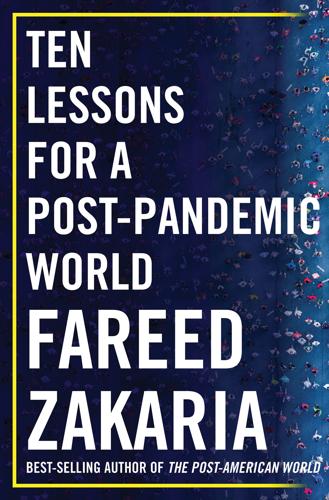
Ten Lessons for a Post-Pandemic World
by
Fareed Zakaria
Published 5 Oct 2020
Some people like the density of city life, others prefer to live farther out in larger homes, but come and go into the city constantly for work and entertainment. This constellation of activity will vary from place to place, but everywhere, the city is the center of the solar system around it. The author Parag Khanna notes that economically, America has really turned into a collection of interlinked metro regions that he dubs, “The United City-States of America.” Big, developed cities are beginning to think of themselves as independent actors on the world stage. As major metro areas have seen their economies and populations grow, mayors have sought to exercise greater political power at the national and even international levels.
…
.: Spatio-Temporal Patterns and Socio-Economic Controls,” Earth’s Future, May 18, 2017, https://doi.org/10.1002/2016EF000511. 134 consuming less . . . electricity: “In almost every metropolitan area, carbon emissions are significantly lower for people who live in central cities than for people who live in suburbs,” in Edward Glaeser, “Green Cities, Brown Suburbs,” City Journal, Winter 2009, https://www.city-journal.org/html/green-cities-brown-suburbs-13143.html. 134 Major European and Asian cities: See Arcadis Sustainable Cities Index 2018, https://www.arcadis.com/media/1/D/5/%7B1D5AE7E2-A348–4B6E-B1D7–6D94FA7D7567%7DSustainable_Cities_Index_2018_Arcadis.pdf; and Robert Muggah and Parag Khanna, “These 10 Asian Cities Are the Most Prepared for the Future,” World Economic Forum, September 5, 2018, https://www.weforum.org/agenda/2018/09/these-asian-cities-are-best-equipped-for-the-future/. 134 Many rural areas in the United States: For instance, reservations like those of the Navajo. See: Ian Lovett, Dan Frosch, and Paul Overberg, “Covid-19 Stalks Large Families in Rural America,” Wall Street Journal, June 7, 2020. 134 Many rural areas . . . in Europe: Ilya Kashnitsky and José Manuel Aburto, “The Pandemic Threatens Aged Rural Regions Most,” Center for Open Science, University of Oxford, and Interdisciplinary Centre on Population Dynamics (CPOP) at University of Southern Denmark, https://ideas.repec.org/p/osf/osfxxx/abx7s.html. 134 Staten Island suffered more than super-dense Manhattan: “Density & COVID-19 in New York City,” Citizens Housing & Planning Council, May 2020, https://chpcny.org/wp-content/uploads/2020/05/CHPC-Density-COVID19-in-NYC.pdf. 135 just eighteen deaths: “Coronavirus Map,” New York Times, accessed July 27, 2020, https://www.nytimes.com/interactive/2020/world/coronavirus-maps.html. 135 “Private doctors have joined the fever camps”: Soutik Biswas, “How Asia’s Biggest Slum Contained the Coronavirus,” BBC, June 23, 2020, https://www.bbc.com/news/world-asia-india-53133843. 136 high risk from natural disasters: United Nations, The World’s Cities in 2018, 9. 136 three decades more: “A Ride Along Chicago’s Red Line: Life Expectancy Varies by 30 Years from One End to the Other,” Economist, October 10, 2019. 137 “As a society urbanizes”: Darrell Bricker and John Ibbitson, Empty Planet: The Shock of Global Population Decline (New York: Crown, 2019). 137 some 80% of the world’s megacities: United Nations, The World’s Cities in 2018, 5. 137 89% by 2050: United Nations, “World Populations Prospects 2019,” https://population.un.org/wpp/. 137 some recent slippage in population: Sabrina Tavernise and Sarah Mervosh, “America’s Biggest Cities Were Already Losing Their Allure.
…
Agnes Buzyn trailed in with just 16%”: Carlton Reid, “Anne Hidalgo Reelected as Mayor of Paris Vowing to Remove Cars and Boost Bicycling and Walking,” Forbes, June 28, 2020. 139 remain car-free: Feargus O’Sullivan, “What Happens to Public Space When Everything Moves Outside,” City Lab, May 29, 2020, https://www.bloomberg.com/news/features/2020–06–29/what-happens-to-public-space-when-everything-moves-outside. 140 “United City-States of America”: Parag Khanna, “A New Map for America,” April 15, 2016, citing Joel Kotkin’s “mega-regions.” See map in the digital version: https://www.nytimes.com/2016/04/17/opinion/sunday/a-new-map-for-america.html. 140 pushed ahead with the agreement: Ivo Daalder, “Why Cities Need Their Own Foreign Policies,” Politico, May 6, 2017. 141 stay in Columbus: Alina Dizik, “New Residents Are Spending Big in Columbus,” Wall Street Journal, November 7, 2019. 141 “Death and Life of Great Cities”: Drawn from the title of Jane Jacobs’s masterwork, The Death and Life of Great American Cities (New York: Random House, 1961). 141 “This City now doth”: William Wordsworth, “Composed Upon Westminster Bridge, September 3, 1802.” 142 “Here is New York”: Elwyn Brooks White, Here Is New York (1949), 21. 142 “Genuine, rich diversity”: Jane Jacobs, “Can Big Plans Solve the Problem of Renewal?
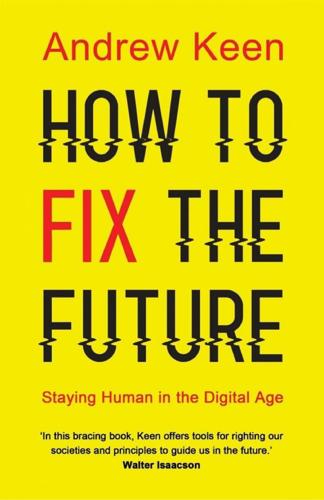
How to Fix the Future: Staying Human in the Digital Age
by
Andrew Keen
Published 1 Mar 2018
The challenge of Lee Hsien Loong—who enjoys writing programming code in his spare time12—is not merely to digitize his father’s successful formula and transform analog Singapore into an E-topia. It’s also to eliminate that “shadow” hanging over his authoritarian father’s legacy—that disdain for democracy—and ensure that the world’s first smart nation is also a democratic one. Geography Is Power I am having afternoon tea with the writer Parag Khanna in Singapore’s Goodwood Park Hotel. It’s a colonial-style building, set in a lushly landscaped six-acre garden just off Scott’s Road, the downtown street named after Captain William G. Scott, a nineteenth-century Englishman who had been Singapore’s harbormaster and postmaster as well as the owner of some of the largest plantations on the island.
…
I think of the messages encoded in Hans Holbein’s representation of Utopia. It occurs to me that, like the ever-changing Singapore, maps are never quite what they appear to be. “It would be like Singapore,” Khanna replies, waving his arm around the tearoom as if it were the whole island. “The geography of the future is a globally connected city.” Parag Khanna is right, of course. The vertiginous map of a hyperconnected Singapore—with its liquid inflows and outflows of networked goods, services, finance, people, and data—is, like it or not, ultimately all of our futures. But we know from Singapore’s ability to “stretch” its land that geography and the making of maps are more than just the representation of physical reality.
…
On the one hand, it is full of warnings of mass surveillance, the overwhelming flood of online personal information, and the destruction of privacy. But the exhibition is also optimistic about the way in which data might enrich democracy and public participation. There are many different maps of Singapore, enough maps to satisfy even Parag Khanna, showing how the Smart Island is collecting and storing data in the cloud as well as providing more and more affordable access for its five and a half million citizens. In a section of the exhibition titled “Data for the Common Good,” there are demonstrations of local Singapore apps designed for the public benefit.

The Future Is Asian
by
Parag Khanna
Published 5 Feb 2019
He has been honored as a Young Global Leader of the World Economic Forum, named one of Esquire’s “75 Most Influential People of the 21st Century,” and featured in Wired magazine’s “Smart List.” MEET THE AUTHORS, WATCH VIDEOS AND MORE AT SimonandSchuster.com Authors.SimonandSchuster.com/Parag-Khanna @simonbooks ALSO BY PARAG KHANNA The Second World: Empires and Influence in the New Global Order How to Run the World: Charting a Course to the Next Renaissance Hybrid Reality: Thriving in the Emerging Human-Technology Civilization Connectography: Mapping the Future of Global Civilization Technocracy in America: Rise of the Info-State We hope you enjoyed reading this Simon & Schuster ebook
…
I’m ever grateful to my parents, Sushil and Manjula Khanna, my in-laws Javed and Zarene Malik, my brother and sister-in-law Gaurav and Anu Khanna, and of course my beloved wife, Ayesha, and our kids, Zara and Zubin, with whom I’m grateful to be building our Asian future. About the Author © HART TAN Dr. Parag Khanna is the Managing Partner of FutureMap, a data-driven scenario-planning and strategic advisory firm that works with some of the world’s most innovative governments, cities, and companies. He has been a fellow at the Brookings Institution, New America, and the Lee Kuan Yew School of Public Policy at the National University of Singapore, and an adviser to the US National Intelligence Council’s Global Trends 2030 program and US Special Operations Forces in Iraq and Afghanistan.
…
Western, 10–11 World War I, 2, 49 World War II, 2, 11, 50–51 xenophobia, of Asians, 329 Xi Jinping, 10, 110, 111, 119, 137, 150, 161, 182, 194, 242, 249, 268, 300, 301–2, 310 Xinjiang, 59, 117, 182, 319 Yang Shihua, 182 Yangtze River, 30, 31, 42 Yellow River, 42 Yemen, 96, 106, 107, 251 yoga, 332 Yom Kippur War, 101 Yongle (Zhu Di), Ming emperor, 42–43 Yuan Dynasty, 40 Yuezhi people, 32 Zambia, 263 Zhang Weiwei, 137 Zhao Tingyang, 137 Zheng He, Chinese admiral, 42, 69 Zhongguo (Middle Kingdom), 30 Zhou Dynasty, 30, 31 Zhou Enlai, 56 Zoroastrianism, 30, 32, 36, 69, 70 ZTE, 194 Simon & Schuster 1230 Avenue of the Americas New York, NY 10020 www.SimonandSchuster.com Copyright © 2019 by Parag Khanna All rights reserved, including the right to reproduce this book or portions thereof in any form whatsoever. For information, address Simon & Schuster Subsidiary Rights Department, 1230 Avenue of the Americas, New York, NY 10020. First Simon & Schuster hardcover edition February 2019 SIMON & SCHUSTER and colophon are registered trademarks of Simon & Schuster, Inc.

The Best Business Writing 2013
by
Dean Starkman
Published 1 Jan 2013
The Naked and the TED The New Republic No one has mastered the art of the long takedown review quite like Evgeny Morozov. In taking on some new e-books published by the increasingly ubiquitous TED conference brand (Hybrid Reality: Thriving in the Emerging Human-Technology Civilization, by Parag Khanna and Ayesha Khanna; The Demise of Guys: Why Boys Are Struggling and What We Can Do About It, by Philip Zimbardo and Nikita Duncan; and Smile: The Astonishing Powers of a Simple Act, by Ron Gutman), Morozov argues that many of the shiny and exciting and easily digestible ideas propagated by TED are actually very dangerous.
…
No, not technology itself; just much of today’s discourse about technology, of which this little e-book is a succinct and mind-numbing example. At least TED Books—the publishing outlet of the hot and overheated TED Conference, which brought this hidden gem to the wider public—did not kill any trees in the publishing process. It might seem odd that Parag Khanna would turn his attention to the world of technology. He established his reputation as a wannabe geopolitical theorist, something of a modern-day Kissinger, only wired and cool. For almost a decade he has been writing pompous and alarmist books and articles that herald a new era in international relations.
…
But perhaps this is what the Hybrid Age is all about: marketing masquerading as theory, charlatans masquerading as philosophers, a New Age cult masquerading as a university, business masquerading as redemption, slogans masquerading as truths. • • • This book is not just useless piffle about technology; it is also an endorsement of some rather noxious political ideas. Those already familiar with Parag Khanna’s earlier celebrations of autocracies in Southeast Asia will not be surprised by some of the most outrageous paragraphs in his TED book. China is one of the Khannas’ role models. They have the guts to write that “a decade from now we will look back at China’s 12th Five-Year Plan as the seminal document of the early 21st century.”
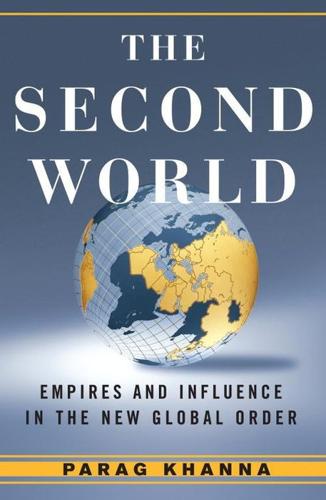
Second World: Empires and Influence in the New Global Order
by
Parag Khanna
Published 4 Mar 2008
But this book is not written for Americans only, for the task of adapting the United States to a world of multiple superpowers and an amorphous but deepening globalization is too important to be left to Americans alone. War may be God’s way of teaching Americans geography, but there is a new geography of power that everyone in the world must understand better. If we do not find common ground in our minds, then nothing can save us. Parag Khanna New York August 2007 INTRODUCTION: INTER-IMPERIAL RELATIONS IN THE 1990S, as bombed-out buildings in the Balkans crumbled, who managed the reconstruction of these war-torn nations? When Mexico’s currency crashed to the point of debt default, who bailed it out? When the former Soviet republics in Central Asia were flung into independence, who settled their borders and boosted their trade?
…
Tauris, 1994); Burgat, Face to Face with Political Islam, 180; Amr Hamzawy, “The Key to Arab Reform: Moderate Islamists,” Carnegie Endowment for International Peace, Policy Brief no. 40, August 2005; and Judy Barsalou, “Islamists at the Ballot Box: Findings from Egypt, Jordan, Kuwait, and Turkey,” United States Institute of Peace, Special Report no. 144, July 2005. 10. Saad Eddin Ibrahim, “Islam Can Vote, If We Let It,” New York Times, May 21, 2005. 11. Lawrence Groo and Parag Khanna, “The Regime Change We Need,” The National Interest, Winter 2006. 12. Steven A. Cook, “The Promise of Pacts,” Journal of Democracy 17, no. 1 (January 2006). 13. “The U.S. Project for Democracy in the Greater Middle East—Yes, but with Whom?” Al-Hayat, February 23, 2004. 14. Shibley Telhami, “In the Middle East, the Third Way Is a Myth,” Washington Post, February 17, 2006. 15.
…
In his masterful rebuttal of Karl von Clausewitz’s famous dictum that “war is the continuation of politics by other means,” historian John Keegan argues that war is natural and cultural—nature, not nurture—preceding even the creation of polities, states, and armies. From cannibalism to conflicts among nations, strife is part of the human condition. Keegan, A History of Warfare (New York: Vintage, 1993). 81. Harold Nicolson, Diplomacy, 13. ABOUT THE AUTHOR Parag Khanna is a senior research fellow and director of the Global Governance Initiative in the American Strategy Program of the New America Foundation. He has been a fellow at the Brookings Institution, and has worked for the World Economic Forum in Geneva and the Council on Foreign Relations. During 2007 he was a senior geopolitical adviser to U.S.
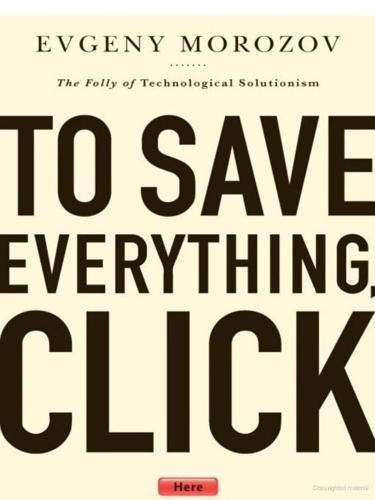
To Save Everything, Click Here: The Folly of Technological Solutionism
by
Evgeny Morozov
Published 15 Nov 2013
Politics is out; technocracy is in. We’ll check some online form to tell the government which potholes to fill, but we won’t discuss whether the workers fixing them need better pay or we need better roads. An even sharper antipolitical—and even antidemocratic—sentiment can be observed in the work of Parag Khanna, the geopolitics wunderkind who has recently reinvented himself as a technology visionary. In Hybrid Reality, coauthored with his wife, Khanna suggests that not just talk but even elections might need to go so that technocratic modes of governance can continue unabated. Drawing on the generativity theory of Jonathan Zittrain—Internet-centrism rears its ugly head again, lending support to crazy governance ideas—Khanna writes, in the euphemistic style of the Chinese politburo, that “a generative governance system can be designed to provide stability and positive change at the same time.”
…
Drawing on the generativity theory of Jonathan Zittrain—Internet-centrism rears its ugly head again, lending support to crazy governance ideas—Khanna writes, in the euphemistic style of the Chinese politburo, that “a generative governance system can be designed to provide stability and positive change at the same time.” What does any of this mean? Well, “positive change” for Parag Khanna means that “using technology to deliberate on matters of national importance, deliver public services, and incorporate citizen feedback may ultimately be a truer form of direct participation than a system of indirect representation and infrequent elections.” Thus, he continues, “we cannot be afraid of technocracy when the alternative is the futile populism of Argentines, Hungarians, and Thais masquerading as democracy.
…
(New York: HarperCollins, 2009), 48. 133 “to the extent that . . . new media”: Anthony Ha, “Sean Parker: Defeating SOPA was the ‘Nerd Spring,’” TechCrunch, March 12, 2012, http://techcrunch.com/2012/03/12/sean-parker-defeating-sopa-was-the-nerd-spring. 133 “a vegetarian trapped inside the sausage factory”: quoted in Steven Levy, In the Plex: How Google Thinks, Works, and Shapes Our Lives (New York: Simon & Schuster, 2011), 327. 133 “an incumbent protection machine”: Derek Thompson, “Google’s CEO: ‘The Laws Are Written by Lobbyists,’” The Atlantic, October 1, 2010, http://www.theatlantic.com/technology/archive/2010/10/googles-ceo-the-laws-are-written-by-lobbyists/63908. 133 “it is overdue to rethink”: Noveck, Wiki Government, 16. 133 “the digital environment offers”: ibid., 40. 133 “most of the work”: ibid., 40. 134 “a generative governance system can”: Parag Khanna and Ayesha Khanna, Hybrid Reality: Thriving in the Emerging Human-Technology Civilization, Kindle ed. (New York: TED Conferences, 2012). 134 “positive change . . . using technology”: ibid., Kindle location 730–731. 134 “we cannot be afraid of technocracy”: ibid., Kindle location 733–734. 134 “To the extent that China provides”: ibid., Kindle location 736–737. 135 “Thinking about government policy sends shivers”: David Ewing Duncan, “Why Do Our Best and Brightest End Up in Silicon Valley and Not D.C.?

The Return of Marco Polo's World: War, Strategy, and American Interests in the Twenty-First Century
by
Robert D. Kaplan
Published 6 Mar 2018
.*36 The Chinese, with their investments in Indian Ocean ports (in Myanmar, Bangladesh, Sri Lanka, Pakistan, Djibouti, and Tanzania), are doing for the postmodern era what the Portuguese did for the late medieval and early modern ones, even while the map lines connecting these new and expanded ports approximate Marco Polo’s return route. The “nexus” of China, the Middle East, and Africa now accounts for more than half of world trade, writes Parag Khanna.*37 This is truly a Chinese maritime empire we are talking about. Like that of the Portuguese, it is mainly limited to the coast, and does not guarantee China pivotal influence inland. Myanmar’s political liberalization offers the example of a country reaching out to India and the United States to avoid domination by China: Geography still rules, but globalization and the communications revolution amplify the opportunities for out-of-area powers.
…
Constance Garnett (1968; reprint, Berkeley: University of California Press, 1973), 390. *3 Reinhold Niebuhr, The Irony of American History (1952; reprint, Chicago: University of Chicago Press, 2008), 74. *4 Halford J. Mackinder, Democratic Ideals and Reality, Defense Classic Edition (Washington, DC: National Defense University Press, 1942), 45–49. *5 Parag Khanna, Connectography: Mapping the Future of Global Civilization (New York: Random House, 2016), 14. *6 ASEAN is the Association of Southeast Asian Nations. *7 Robert D. Kaplan, Monsoon: The Indian Ocean and the Future of American Power (New York: Random House, 2010), chap. 1. *8 Laurence Bergreen, Marco Polo: From Venice to Xanadu (New York: Knopf, 2007), 44, 68

The Fourth Revolution: The Global Race to Reinvent the State
by
John Micklethwait
and
Adrian Wooldridge
Published 14 May 2014
It could reach 75 percent in 2050: In the developing world more than one million people move to cities every five days. Some cities are veritable behemoths: Chongqing, where Bo Xilai had his power base, sits at the heart of a region of thirty million people, six times the population of Denmark and about the same as the population of Canada. Cities are also the locus of the knowledge-economy: Parag Khanna of the New America Foundation, a think tank, calculates that forty city-regions produce two-thirds of the world’s economic output and an even higher share of its innovations. Gerald Carlino of the Federal Reserve Bank of Philadelphia notes that the denser the city, the more inventive: The number of patents per head rises by an average of 20 percent to 30 percent for each doubling of the number of employed people per square kilometer.
…
Prasad Eye Institute, 204–5 Mac 400, 205 Macartney, George, 41 Macaulay, Thomas Babington, 222, 224–26 McConnell, Mitch, 256 McDonald’s, 157, 185 McGregor, Richard, 151, 157 Machiavelli, Niccolò, 29, 33 McKinsey, 194–95, 204 Macmillan, Harold, 69 Macrae, Norman, 75 Madison, James, 265 Ma Hong, 158–59 majority, tyranny of, 226, 250, 255 management, reinvention of, 189–92 Mandela, Nelson, 252 Mandelson, Peter, 95 Manhattan Institute, 82 Mann, Thomas, 125–26, 227 Manning, Bradley, 230 Manor, Tex., 210 Man Versus the State, The (Spencer), 59 Mao Zedong, 151 Marshall, Alfred, 233 Marshall, T.H., 74 Martineau, Harriet, 54 Marx, Karl, 45, 62–63, 70 state as seen by, 63–64 Marxism, see Communists, communism Mary II, Queen of England, 43 Mary Barton (Gaskell), 57 Mazzini, Giuseppe, 54 means testing, 243, 245 Meat Inspection Act (U.S., 1906), 72 Medicaid, 242 Medicare, 120, 123, 242 Medisave, 243 mercantilism, 40 Merkel, Angela, 12, 16, 230, 231 Mettler, Suzanne, 121 micro-powers, 260, 266 middle class, 124 entitlements and, 11, 17 government spending and, 11 as primary beneficiary of welfare state, 122 welfare state and, 17, 88 Middle East: China and, 152 failure of democracy in, 253 local government in, 217 Miliband, Ed, 114, 153 Milken, Michael, 129 Mill, James, 47, 48–49, 53, 140 Mill, John Stuart, 7, 9, 21, 27–28, 69, 80, 85, 135, 136, 219, 251, 255 background of, 47 expanded role of government embraced by, 56–57 freedom as overriding concern of, 47–48, 55, 222, 224, 226, 228, 250, 256, 268 free trade promoted by, 55 intellectual freedom as tenet of, 55 meritocracy promoted by, 53, 237 as public intellectual, 47 Mindlab, 220 Mises, Ludwig von, 83 Mississippi, 111 Modi, Narendra, 218 Moïsi, Dominique, 166 money politics, 256–58 Montefiore Medical Center, 209 Monti, Mario, 259 Mont Pelerin Society, 83, 85 Moody’s, 119 Morrill Act (U.S., 1862), 62 Morsi, Mohamed, 253 Moynihan, Daniel Patrick, 89 Mubarak, Hosni, 144, 253 Muggeridge, Malcolm, 67 Mughal Empire, 36 Mulgan, Geoff, 132 Musacchio, Aldo, 153 Muslim Brotherhood, 144, 253 Mussolini, Benito, 252 Myrdal, Alva, 169, 170 Myrdal, Gunnar, 37, 169, 170 Naím, Moisés, 186, 260, 266 Nanjing, 35 Napoléon I, Emperor of the French, 46 Narayana Hrudayalaya Hospital, Bangalore, 201 National Audit Office, British, 199 National Education Association, 114 National Front, French, 259 National Health Service, British, 62, 82, 109, 183, 199, 205 spending on, 130–31 National Health Service Act (British, 1948), 75 National Institute for Health and Care Excellence (NICE), 243 National Insurance Act (British, 1946), 75 National Journal, 256 National Labor Relations Board, 73 national minimum, 68, 69 National Statistics Office, British, 19, 177 nation-state, 6, 8, 221 commerce and, 33 democracy and, 259, 262 globalization and, 259–60, 262 government efficiency in, 37 innovation and, 37, 39 legitimacy of, 33 local-government resistance to, 260 minimal welfare vote of, 33 representative institutions in, 38 rights of citizens in, 30, 43–44 rule of law in, 37–38 security as primary duty of, 29, 30, 32, 37, 39, 181, 222, 268 Navigation Acts, 50 Nazis, 71, 232 neoconservatives, 89 Netherlands, government spending in, 75 New Brutalism, 89 New Deal, 72, 82, 192, 236 New Digital Age, The (Schmidt and Cohen), 210–11 New Labourites, 94–95, 99 Newnham College, 58 New Republic, 71 New Statesman, 67 Newsweek, 86 New York Daily News, 227 New Zealand, 239 Niebuhr, Reinhold, 265 Nigeria, 234 night-watchman state, 7, 9, 48, 61, 80, 86, 101, 136, 140, 181, 232 1984 (Orwell), 71 Nixon, Richard, 77 Nobel Prize, 82, 86, 91 Nock, Albert Jay, 177 nongovernmental organizations (NGOs), Chinese, 158 Northcote, Stafford, 52–53 Norway, 1990s financial crisis in, 176 Novey, Don, 112–13, 181 Nye, Joseph, 3, 198 Obama, Barack, 100, 126, 192, 236, 241, 255, 256 big-government ideology of, 98 health-care reforms of, 20, 98, 117, 199, 208, 217 pragmatism of, 98, 220 Obama administration, 220, 231 regulation and, 117 occupational legislation, 117–18 O’Donnell, Christine, 227–28 OECD (Organization for Economic Cooperation and Development), 186 Office of Social Innovation and Participation, U.S., 220 “Old Corruption,” 6, 49, 51, 58, 149, 185, 227, 256, 268, 269 Oldham, John, 195 Olivares, Count-Duke, 37 Olson, Mancur, 109–10, 111 Olson’s law, 111–15, 117, 124, 237 On Liberty (Mill), 55, 59, 69 Open Society and Its Enemies, The (Popper), 83 Open University, 180 opinion, freedom of, 224 Orban, Viktor, 254 Organization for Economic Cooperation and Development (OECD), 186 Ornstein, Norman, 125–26, 227 Orwell, George, 71 Ottoman Empire, 35 Our Enemy, the State (Nock), 177 Packard, David, 105 Paine, Thomas, 21, 43–44 Pall, Niti, 206 Palme, Olof, 170, 175 Palo Alto, Calif., 105, 106 Papademos, Lucas, 259 Parag, Khanna, 218 Parliament, British, 31, 43 Party, The (McGregor), 151 Party for Freedom, Dutch, 259 patronage, 50, 52–53, 222, 237, 240 Paul, Ron, 34 payroll withholding tax, 82 Peace Corps, 216 Peace of Westphalia (1648), 38 Pearson, Karl, 68 Peel, Robert, 51, 54 pensions, 16, 267 Asian expansion of, 141–42 in Brazil, 18 in California, 113, 115, 119–20, 130 in China, 156, 183 defined-benefit vs. defined-contribution systems of, 184 as entitlements, 79, 184, 243 in Scandinavia, 171, 173, 184 spiking of, 184 as unfunded liabilities, 14, 119 People’s Action Party, Singapore, 134, 137–38 Peterson, Pete, 131 Peterson Foundation, 255 Peterson Institute for International Economics, 154 PetroChina, 152, 154, 155 Philippines, health insurance in, 141 Philippon, Thomas, 239 philosophical radicals, 48, 49, 85, 181 physician’s assistants, 204 Plato, 250, 255, 260, 264 pluralism, 211–14 police, technology and, 181–82 Political Economy (Mill), 57 political parties, declining membership in, 11, 261 politics: government bloat and, 10–11 money in, 256–58 polarization of, 11–13, 100, 124–27, 164, 255, 256 talent flight from, 127 Pomperipossa effect, 170 poor, poverty: failure of welfare state programs for, 87–89 public spending as biased against, 122–24 welfare state and, 68 Popper, Karl, 83 population: aging of, 15, 122–23, 124, 165, 174, 178, 183–84, 232, 241–42 urban shift of, 149, 218 Porter, Michael, 131 Portugal, public spending in, 99–100 Potter, Laurencina, 65–66 Potter, Richard, 65 Principles of Political Economy (Mill), 55 Pritchett, Lant, 147 private life, freedom of, 224 privatization, 8, 94, 96, 234–37 Procter & Gamble, 190 productivity, 178 Baumol’s disease and, 110 in public vs. private sectors, 18–20, 177, 285 state capitalism and, 154 Programme for International Student Assessment (PISA), 148, 206–7 Progressive Party, 72 progressivism, 240 as self-defeating, 229–30 property rights, 40, 43, 224 Proposition 13, 91, 92, 107 Protestants, 38 public sector, 76, 89, 115, 177, 180 technology and, 180 Pudong, China, 1–5, 8 Pune, India, 218–19 Pure Food and Drug Act (U.S., 1906), 72 Putin, Vladimir, 144, 153, 253 Pythagorean theorem, 31 Qianlong, Emperor of China, 41 racism, 88 Rauch, Jonathan, 231 Reagan, Ronald, 8, 28, 88, 91–92, 97, 198 Friedman and, 86 small-government ideology of, 95 see also Thatcher-Reagan revolution reason, religion as opponent of, 48 Reform, 203 Reformation, 48–49 Reinfeldt, Fredrik, 184 religion: freedom of, 224 reason as opponent of, 48 rent control, 82 rent seeking, 239 “Report on Manufacturers” (Hamilton), 150 Republic, The (Plato), 250 Republican Party, U.S., 123, 236–37 increased taxes opposed by, 100, 255 tax rises approved by, 12 Reshef, Ariell, 239 retirement age, 184–85, 242 Reykjavik City Council, 261 Ricardo, David, 49 Richelieu, Cardinal, 37 Right, 82, 93 government bloat and, 10–11, 98 government efficiency and, 187 and growth of big government, 10, 95, 98, 228, 230–31 privatization and, 234, 236–37 welfare services opposed by, 88, 185 rights: Fourth Revolution and, 270 liberal state’s expansion of, 7, 48, 49, 51 in nation-state, 30, 43–44 of property, 40, 43, 224 protection of, as primary role of liberal state, 45 see also freedom Rights of Man, The (Paine), 44 Ripley, Amanda, 206–7 road pricing, 217 Road to Serfdom, The (Hayek), 10, 83, 86 Rodrik, Dani, 262 Romney, Mitt, 217 “Roofs or Ceilings” (Friedman), 82 Roosevelt, Franklin Delano, 72–73, 252 Roosevelt, Theodore, 71–72, 258 rotten boroughs, 51, 125, 227, 251, 257, 269 see also gerrymandering Rousseau, Jean-Jacques, 44, 45 Rousseff, Dilma, 153 Royal Society, 42 Rumsfeld, Donald, 77, 253 Russia, 71 China and, 152 corruption in, 186 failure of democracy in, 253, 262 privatization in, 96 Singapore model admired by, 144 state capitalism in, 153, 154 Russian Revolution, 45 Rwanda, 144 Sacramento, Calif., 105, 106, 127 Sahni, Nikhil, 200 St.
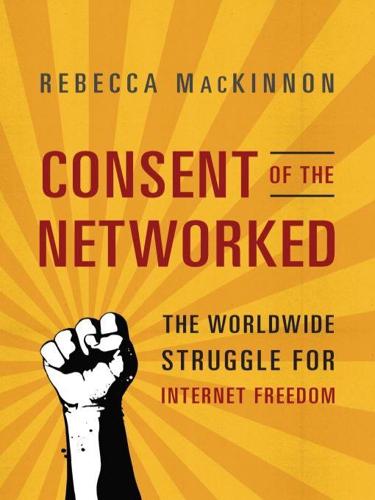
Consent of the Networked: The Worldwide Struggle for Internet Freedom
by
Rebecca MacKinnon
Published 31 Jan 2012
Nye Jr., The Future of Power (New York: PublicAffairs, 2011). 11 Other kinds of transnational organizations are also challenging the power of nation-states: One of the earliest policy analyses of the challenge posed by transnational organizations to the power of nation-states, and how the Internet had amplified the power of new actors, was by Jessica T. Matthews, “Power Shift,” Foreign Affairs 76, no. 1 ( January/February 1997), 50–66. Parag Khanna argues that the world is entering a new phase that he calls the “new medievalism,” in which states must share power with other transnational actors. Parag Khanna, How to Run the World: Charting a Course to the Next Renaissance (New York: Random House, 2011). 13 Communication Power: Manuel Castells, Communication Power (New York: Oxford University Press, 2009), 346–362, 431–432.
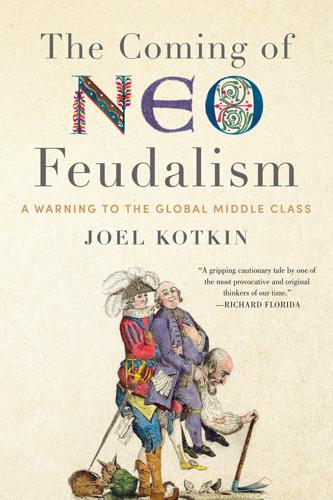
The Coming of Neo-Feudalism: A Warning to the Global Middle Class
by
Joel Kotkin
Published 11 May 2020
Beard, The Rise of American Civilization (New York: Macmillan, 1930), vol. 2: 385. 17 James Cherowbrier, “Leading billionaire cities in Europe in 2014 and 2016, by billionaire population,” Statista, March 2017, https://www.statista.com/statistics/434709/leading-bilionaire-cities-europe/; WealthX, “The WealthX Billionaire Census 2018,” May 15, 2018, https://www.wealthx.com/report/the-wealth-x-billionaire-census-2018/; Stratfor, “Mapping the World’s Wealthiest Cities,” February 22, 2018, https://worldview.stratfor.com/article/mapping-worlds-wealthiest-cities. 18 Daniel W. Drezner, “ ‘Connectography’ by Parag Khanna,” New York Times, May 1, 2016, https://www.nytimes.com/2016/05/01/books/review/connectography-by-parag-khanna.html?_r=0; Simon Curtis, “What Comes After the End of the Global City?” De Gruyter Conversations, April 17, 2018, https://blog.degruyter.com/what-comes-after-the-end-of-the-global-city/; Joseph Gyourko et al., “Superstar Cities,” National Bureau of Economic Research, July 2006, https://www.nber.org/papers/w12355. 19 Wendell Cox, “Paris, London Lead European Metropolitan Areas: Latest Data,” New Geography, July 10, 2019, http://www.newgeography.com/content/006349-paris-london-lead-european-metropolitan-areas-latest-data; Christophe Guilluy, Twilight of the Elites: Prosperity, the Periphery, and the Future of France, trans.

The Industries of the Future
by
Alec Ross
Published 2 Feb 2016
Two weeks later, Shamoon: Bronk, interview; Camilla Hall and Javier Blas, “Aramco Cyber Attack Targeted Production,” Financial Times, December 10, 2012, http://www.ft.com/intl/cms/s/0/5f313ab6-42da-11e2-a4e4-00144feabdc0.html#axzz2qP9F3kEY; Bronk and Tikk-Ringas, “Hack or Attack?” Saudi Aramco is responsible: Parag Khanna, “The Rise of Hybrid Governance,” McKinsey & Company, October 2012, http://www.mckinsey.com/insights/public_sector/the_rise_of_hybrid_governance. Little did it know that its: Christopher Bronk and Eneken Tikk-Ringas, “The Cyber Attack on Saudi Aramco,” Survival: Global Politics and Strategy, April–May 2013, 81–96, http://www.iiss.org/en/publications/survival/sections/2013-94b0/survival–global-politics-and-strategy-april-may-2013-b2cc/55-2-08-bronk-and-tikk-ringas-e272; Jim Garamone, “Panetta Spells Out DOD Roles in Cyberdefense,” American Forces Press Service, US Department of Defense, October 11, 2012, http://www.defense.gov/news/newsarticle.aspx?
…
He has proposed that Detroit: Andreessen, “Turn Detroit into Drone Valley.” Today 54 percent of the world’s: “World’s Population Increasingly Urban with More Than Half Living in Urban Areas,” United Nations, July 10, 2014, http://www.un.org/en/development/desa/news/population/world-urbanization-prospects-2014.html; Parag Khanna, “Beyond City Limits,” Foreign Policy, August 16, 2010, http://www.foreignpolicy.com/articles/2010/08/16/beyond_city_limits?page=0,0. Cities are incubators of growth: Andrew F. Haughwout and Robert P. Inman, “How Should Suburbs Help Their Central Cities? Growth and Welfare Enhancing Intra-metropolitan Fiscal Distributions,” Federal Reserve Bank of New York, 2004, http://www.newyorkfed.org/research/economists/haughwout/suburbs_help_central_cities_haughwout.pdf.

The People vs. Democracy: Why Our Freedom Is in Danger and How to Save It
by
Yascha Mounk
Published 15 Feb 2018
Drezner, The Ideas Industry: How Pessimists, Partisans, and Plutocrats Are Transforming the Marketplace of Ideas (New York: Oxford University Press, 2017). 128. See “Mehrheit der Deutschen gegen neue Griechen-Milliarden,” Spiegel Online, February 2, 2012. 129. See Fareed Zakaria, The Future of Freedom (New York: Norton, 2007); and Parag Khanna, Technocracy in America (Parag Khanna, self-published, 2017). 130. See Richard Tuck, “The Left Case for Brexit,” Dissent, June 6, 2016, https://www.dissentmagazine.org/online_articles/left-case-brexit; and Tuck, “Brexit: A Prize in Reach for the Left,” Policy Exchange, July 17, 2017, https://policyexchange.org.uk/pxevents/brexit-a-prize-in-reach-for-the-left/. 3.

The Relentless Revolution: A History of Capitalism
by
Joyce Appleby
Published 22 Dec 2009
Mark Magnier, “Bribery and Graft Taint Every Facet of Life in China,” Los Angeles Times, December 29, 2008. 30. Barry Naughton, “China: Which Way the Political Economy?,” Paper delivered at the UCLA Brenner Seminar, April 9, 2007. 31. Lin, “Lessons of China’s Transition”: 3. The opinion expressed is that of Grzegorz W. Kolodko. 32. Parag Khanna, “Waving Goodbye to Hegemony,” New York Times Magazine, January 27, 2008. 33. Manu Goswami, Producing India: From Colonial Economy to National Space (Chicago, 2004), 46–53. 34. Ibid., 224–26, 233. 35. Pranah Bardhan, “What Makes a Miracle?: Some Myths about the rise of China and India,” Boston Review (January–February 2008); Heston and Sicular, “China and Development Economics,” 31. 36.
…
Deepak Lal, Reviving the Invisible Hand: The Case for Classical Liberalism in the Twenty-first Century (Princeton, 2006), 214–19. 34. Elisabeth Rosenthal, “European Support for Bicycles Promotes Sharing of the Wheels,” New York Times, November 10, 2008. 35. Fareed Zakaria, “Is America in Decline? Why the United States Will Survive the Rise of the Rest,” Foreign Affairs, 87 (2008): 26–27; Parag Khanna, “Waving Goodbye to Hegemony,” New York Times Magazine, January 27, 2008. 36. Joseph A. Schumpter, Capitalism, Socialism and Democracy, 3rd ed. (New York, 1950), 61. Table of Contents Acknowledgments 1. The Puzzle of Capitalism 2. Trading in New Directions 3. Crucial Developments in the Countryside 4.
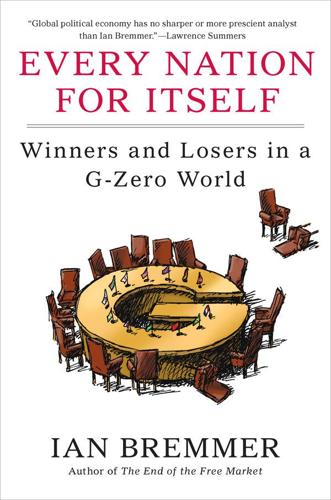
Every Nation for Itself: Winners and Losers in a G-Zero World
by
Ian Bremmer
Published 30 Apr 2012
My gratitude to all my friends and colleagues willing to listen to my thoughts and improve upon them: Peter Apps, Matthew Bishop, Vint Cerf, Steve Clemons, Jared Cohen, Sam DiPiazza, Catherine Fieschi, Chrystia Freeland, David Fromkin, Martina Gmur, Ken Griffin, Nikolas Gvosdev, Guy Hands, Ken Hersh, Zachary Karabell, Tom Keene, Parag Khanna, Sallie Krawcheck, Dan and Eric Loeb (no relation), Steve Mann, Maziar Minovi, Bijan Mossavar-Rahmani, Nader Mousavizadeh, Martin Nagele, Mary Pang, Niko Pfund, Juan Pujadas, Gideon Rachman, Doug and Heidi Rediker, Joel Rosenthal, Marci Shore, Doug Shuman, Martin Sorrell, Larry Summers, Nick Thompson, Enzo Viscusi, Fareed Zakaria, and Bob Zoellick.
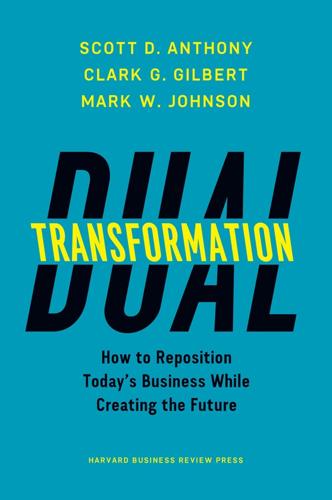
Dual Transformation: How to Reposition Today's Business While Creating the Future
by
Scott D. Anthony
and
Mark W. Johnson
Published 27 Mar 2017
By the time this book hits the shelf, my family will have celebrated our seventh anniversary in Singapore. It continues to feel like a grand adventure. I’m thankful for all of the friends that have helped to keep it interesting, like Fidah Alsagoff, Bill Chang, Paul Cobban, Rachel Eng, Nick Evans, Kuen Loon Ho, Parag Khanna, Koh Boon Hwee, Tony May, Bernard Nee, Dilhan Pillay, Guillaume Sachet, Shaun Seow, Tan Ka Huat, Teo Ming Kian, Kwee Eng Thien, SC Tien, Ernest Wong, Zia Zaman, and many others. I’m also thankful that my friends at Manila Water, notably Gerry Ablaza, Ferdz dela Cruz, and Boogz Baffrey, and at Singtel, namely Tony May and Chua Sock Koong, were gracious enough to share their inspiring stories with broader audiences.

Reinventing Capitalism in the Age of Big Data
by
Viktor Mayer-Schönberger
and
Thomas Ramge
Published 27 Feb 2018
—Philip Evans, senior adviser at The Boston Consulting Group and BCG Fellow “It’s vogue today to proclaim the ‘death of capitalism’—and yet the one truly global system is going through profound reinvention as a combination of technological forces reshape every aspect of our economic, political, and social lives. This book is an absolutely essential guide to our collective digital future and equally importantly, a sensible manifesto to shape it for everyone’s benefit.” —Parag Khanna, author of Connectography: Mapping the Future of Global Civilization and Technocracy in America: Rise of the Info-State NOTES CHAPTER 1: REINVENTING CAPITALISM the online marketplace’s twentieth-anniversary event: Marco della Cava, “EBay Turns Twenty with Sales Plan Aimed at Rivals Like Amazon,” USA Today, September 16, 2015, http://www.usatoday.com/story/tech/2015/09/16/ebay-turns-20-sales-plan-aimed-rivals-like-amazon/72317234.

Future Crimes: Everything Is Connected, Everyone Is Vulnerable and What We Can Do About It
by
Marc Goodman
Published 24 Feb 2015
Massive Anonymous ‘Million Mask March’ as It Happened,” RT, Dec. 24, 2013; “Anonymous (Group),” Wikiquote. 35 When MasterCard, Visa: Lauren Turner, “Anonymous Hackers Jailed for DDoS Attacks on Visa, MasterCard, and PayPal,” Independent, Jan. 24, 2013. 36 Anonymous is strongly against: Karol Snapbacks, “Anonymous Explaining Why They Hacked PSN/Sony,” YouTube, April 22, 2011; Quinn Norton, “Anonymous Goes After World Governments in Wake of Anti-SOPA Protests,” Wired, Jan. 25, 2012; Lisa Vaas, “Anonymous Bullies Sony and Nintendo over SOPA Support,” Naked Security, Jan. 3, 2012. 37 Anonymous views itself: Quinn Norton, “How Anonymous Picks Targets, Launches Attacks, and Takes Powerful Organizations Down,” Wired, July 3, 2012. 38 Even some of the group’s most ardent critics: “Hackers Take Down Child Pornography Sites,” BBC, Oct. 24, 2011. 39 In recognition of their growing power: Barton Gellman, “The World’s 100 Most Influential People: 2012,” Time, April 18, 2012. 40 Their burgeoning influence and capabilities: “Snowden Leaks: GCHQ ‘Attacked Anonymous’ Hackers,” BBC, Feb. 5, 2014. 41 Meanwhile, terrorist organizations too: For detailed information on terrorist and jihadist use of technology, see the United Nations Counterterrorism Implementation Task Force report Countering the Use of the Internet for Terrorist Purposes, May 2011. 42 “do the things you”: Paul Tassi, “ISIS Uses ‘GTA 5’ in New Teen Recruitment Video,” Forbes, Sept. 20, 2014. 43 Internet reconnaissance and research: Thomas Harding, “Terrorists ‘Use Google Maps to Hit UK Troops,’ ” Telegraph Online, Jan. 13, 2007; Caroline McCarthy, “Report: JFK Terror Plotters Used Google Earth,” CNET, June 4, 2007. 44 For instance, “Ramzi Yousef”: Jack Kelley, “Terror Groups Hide Behind Web Encryption,” USA Today, Feb. 5, 2001. 45 Widely available online are documents: Gabriel Weimann, How Modern Terrorism Uses the Internet, United States Institute of Peace, Special Report 116, March 2004. 46 In a striking example of how dangerous: “Search of Tsarnaev’s Phones, Computers Finds No Indication of Accomplice, Source Says,” NBC News, April 23, 2013. 47 “The trio reportedly made fraudulent”: Counter-terrorism Implementation Task Force, Countering the Use of the Internet for Terrorist Purposes, May 2011, 18. 48 Even the infamous 2002 Bali bombing mastermind: Q&A with Tom Kellermann, “Internet Fraud Finances Terrorism,” Discovery News, Feb. 11, 2013. 49 Samudra was technologically savvy: Alan Sipress, “An Indonesian’s Prison Memoir Takes Holy War into Cyberspace,” Washington Post, Dec. 14, 2004. 50 Terrorists seem to be getting: Jeremy Scott-Joynt, “Warning Signs for the Funding of Terror,” BBC, July 20, 2005; Gordon Rayner and David Williams, “Revealed: How MI5 Let 7/7 Bombers Slip Through Their Fingers,” Daily Mail, May 1, 2007. 51 The Filipino hacking cell: Associated Press, “Filipino Police Arrest 4 Suspected AT&T Hackers,” CBS News, Nov. 27, 2011; Somini Sengupta, “Phone Hacking Tied to Terrorists,” New York Times, Nov. 26, 2011; Daily Mail Reporter, “Four Filipinos Arrested for Hacking AT&T Phone ‘to Fund Saudi Terror Group,’ ” Daily Mail, Nov. 28, 2011; Jennifer Rowland, “The LWOT: Phone Hacking Linked to Terrorist Activity,” Foreign Policy, Nov. 29, 2011. 52 Though the average Internet user: Marc Goodman and Parag Khanna, “The Power of Moore’s Law in a World of Geotechnology,” The National Interest, February 2013. 53 Though a $50,000 criminal: Siobhan Gorman, August Cole, and Yochi Dreazen, “Computer Spies Breach Fighter-Jet Project,” Wall Street Journal, April 21, 2009. 54 In May 2013: Ernesto Londono, “Pentagon: Chinese Government, Military Behind Cyberspying,” Washington Post, May 6, 2013. 55 Over the years, it has been reported: Ellen Nakashima, “Confidential Report Lists U.S.
…
Chapter 3: Moore’s Outlaws 1 According to the International Telecommunication Union: Miniwatts Marketing Group, “Internet Users in the World,” Internet World Stats, Dec. 31, 2013, http://www.internetworldstats.com/. 2 Though it took nearly forty years: Miniwatts Marketing Group, “Internet Growth Statistics,” Internet World Stats, Feb. 6, 2013, http://www.internetworldstats.com/. 3 The greatest growth: Miniwatts Marketing Group, “Internet Users in the World, Distribution by World Regions,” Internet World Stats, Feb. 5, 2014, http://www.internetworldstats.com/. 4 And while half the world: Doug Gross, “Google Boss: Entire World Will Be Online by 2020,” CNN, April 15, 2013. 5 The concept was named: Marc Goodman and Parag Khanna, “Power of Moore’s Law in a World of Geotechnology,” National Interest, Jan./Feb. 2013. 6 Incredibly, it literally: Cliff Saran, “Apollo 11: The Computers That Put Man on the Moon,” Computer Weekly, July 13, 2009. 7 The modern smart phone: Peter Diamandis, “Abundance Is Our Future.” TED Talk, Feb. 2012. 8 As a result of mathematical repercussions: Ray Kurzweil, “The Law of Accelerating Returns,” Kurzweil Accelerating Intelligence, March 7, 2001. 9 “law of accelerating returns”: Ray Kurzweil, The Singularity Is Near: When Humans Transcend Biology (New York: Penguin, 2006). 10 Early criminal entrepreneurs: Evan Andrews, “6 Daring Train Robberies,” History.com, Oct. 21, 2013. 11 Their carefully planned heist: Brett Leppard, “The Great Train Robbery: How It Happened,” Mirror, Feb. 28, 2013. 12 The incident kept the PlayStation: Keith Stuart and Charles Arthur, “PlayStation Network Hack: Why It Took Sony Seven Days to Tell the World,” Guardian, Feb. 5, 2014; “Credit Card Alert as Hackers Target 77 Million PlayStation Users,” Mail Online, Feb. 5, 2014. 13 In the end, financial analysts: J.

The Post-American World: Release 2.0
by
Fareed Zakaria
Published 1 Jan 2008
As the Iraq war drags on and China rises, the larger story of the post–Cold War era has come into sharp relief: We are not the center of the universe. It matters less that particular countries are pro- or anti-American than that the world is increasingly non-American. We need to get over ourselves.” —Parag Khanna, Washington Post Book World “Zakaria . . . is judicious, reasonable, smooth, [and] intelligent. . . . He points out that, aside from some pockets of backwardness, the whole world has been getting much richer. . . . Even though the economic scene looks gloomier now than it did when he finished his book, Zakaria is correct to insist that many people everywhere have benefitted from the global boom.”

The Dawn of Eurasia: On the Trail of the New World Order
by
Bruno Macaes
Published 25 Jan 2018
In 2011 Putin told participants at a conference in the White Sea port city of Arkhangelsk that Russia would be investing massively in the Arctic region in a bold bid to challenge traditional trade lanes. Perhaps different countries and cities will soon begin to compete to attract investment and people to the new trade route. Will there be a capital of the Arctic? In his Connectography, Parag Khanna suggests that Kirkenes in Norway may be the best candidate for the role, but Murmansk in Russia, just 200 kilometres to the south-east and founded in 1916, starts with considerable advantages. It is by far the largest settlement within the Arctic Circle and in 2016 its port handled more than 30 million tonnes of goods, a 50 per cent increase from 2015.

Globish: How the English Language Became the World's Language
by
Robert McCrum
Published 24 May 2010
Tony Judt, Postwar: A History of Europe Since 1945 (London, 2007). —, Reappraisals: Reflections on the Forgotten Twentieth Century (London, 2008). Fred Kaplan, Lincoln: The Biography of a Writer (New York, 2008). Thomas Keneally, Lincoln (London, 2003). Frank Kermode, The Age of Shakespeare (London, 2004). Parag Khanna, The Second World: Empires and Influence in the New Global Order (London, 2008). Mark Kishlansky, A Monarchy Transformed: Britain 1603–1714 (London, 1996). Naomi Klein, The Shock Doctrine: The Rise of Disaster Capitalism (London, 2007). James Kynge, China Shakes the World (London, 2006). Mark Leonard, What Does China Think?
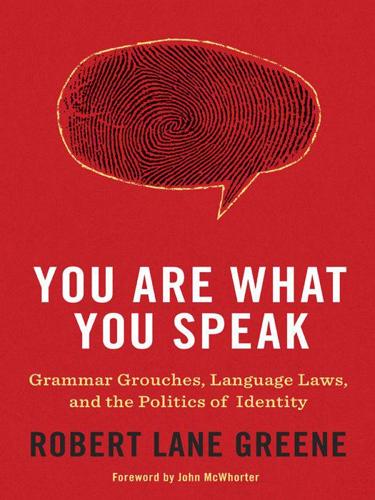
You Are What You Speak: Grammar Grouches, Language Laws, and the Politics of Identity
by
Robert Lane Greene
Published 8 Mar 2011
And I am grateful to my boss, John Micklethwait, for the time off from The Economist during which I wrote this. Some of the material appeared in different form in the pages of that publication. Numerous friends and experts read chapters, catching errors and infelicities: Ilker Aytürk, Robert Greenberg, Prashant Keshavmurthy, Parag Khanna, Victor Mair, Prune Perromat, Don Ringe, and Ann Senghas. Stewart James-Lejárcegui gave a particularly sharp and helpful read of the whole thing. Bill Poser answered questions about China and Japan, as did Mohamed Maamouri about Arabic, and Geoff Pullum has been a lively correspondent over the years.
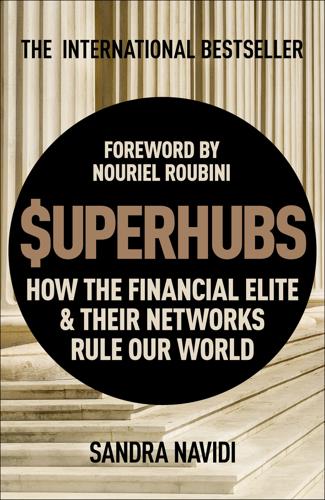
SUPERHUBS: How the Financial Elite and Their Networks Rule Our World
by
Sandra Navidi
Published 24 Jan 2017
In this personal account of rising from outsider to insider among today’s levers of global power, Sandra Navidi explains how the many high-profile names, readers will recognize in these pages, are themselves hubs and connectors, and how their relations to each other are the bonds of influence that shape the world.” —PARAG KHANNA, Senior Research Fellow in the Centre on Asia and Globalisation at the Lee Kuan Yew School of Public Policy at the National University of Singapore, global strategist, author, Managing Partner of Hybrid Reality, and Cofounder & CEO of Factotum “This book is unique in describing and analyzing the human behavior in the upper circles of the global financial system.
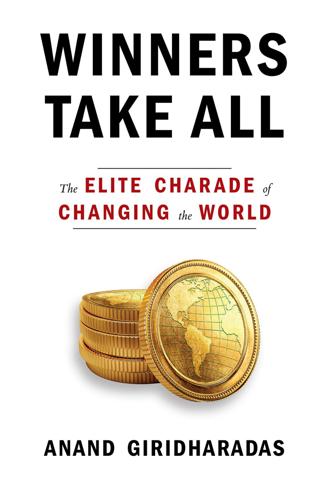
Winners Take All: The Elite Charade of Changing the World
by
Anand Giridharadas
Published 27 Aug 2018
Thought leaders tend, Drezner says, to “know one big thing and believe that their important idea will change the world”; they are not skeptics but “true believers”; they are optimists, telling uplifting stories; they reason inductively from their own experiences more than deductively from authority. They go easy on the powerful. Susan Sontag, William F. Buckley Jr., and Gore Vidal were public intellectuals; Thomas L. Friedman, Niall Ferguson, and Parag Khanna are thought leaders. Public intellectuals argue with each other in the pages of books and magazines; thought leaders give TED talks that leave little space for criticism or rebuttal, and emphasize hopeful solutions over systemic change. Public intellectuals pose a genuine threat to winners; thought leaders promote the winners’ values, talking up “disruption, self-empowerment, and entrepreneurial ability.”

The Raging 2020s: Companies, Countries, People - and the Fight for Our Future
by
Alec Ross
Published 13 Sep 2021
This transaction—economic prosperity for political submission—is the core of the Chinese social contract. Instead of gaining the consent of the governed through the ballot box, the Chinese Communist Party did it through their wallets. “China has five thousand years of centralized political history. It’s not going to become democratic tomorrow,” said geopolitical analyst Parag Khanna. “We thought that they could liberalize, democratize once they joined the World Trade Organization and became part of the global economy—we were wrong. “The [Chinese Communist] Party has bought off the people through material welfare in exchange for political silence,” he added. Most recently, as the Chinese government encroached further into the physical and digital lives of its people, it also tightened its grip on the private sector.
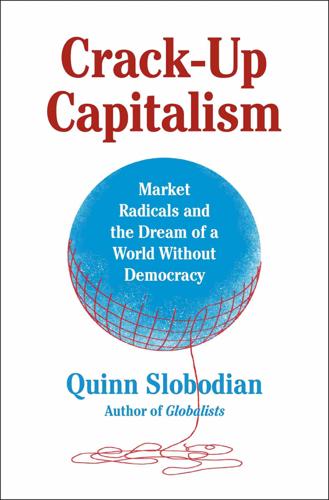
Crack-Up Capitalism: Market Radicals and the Dream of a World Without Democracy
by
Quinn Slobodian
Published 4 Apr 2023
Srinivasan thought about his project as, in part, a talent finding to the world beyond the industrial core. Like the Hubble Telescope that sought dark matter, he said mobile phones would help find what he called “dark talent.” Kosloff and Srinivasan, “#3 Network State with Balaji Srinivasan, former CTO of Coinbase and Founder of 1729.” 74. Parag Khanna and Balaji Srinivasan, “Great Protocol Politics,” Foreign Policy, December 11, 2021, https://foreignpolicy.com/2021/12/11/bitcoin-ethereum-cryptocurrency-web3-great-protocol-politics/. 75. COVID-19 National Preparedness Collaborators, “Pandemic Preparedness and COVID-19: An Exploratory Analysis of Infection and Fatality Rates, and Contextual Factors Associated with Preparedness in 177 Countries, from Jan 1, 2020, to Sept 30, 2021,” Lancet, February 1, 2022, https://doi.org/https://doi.org/10.1016/S0140–6736(22)00172–6. 76.
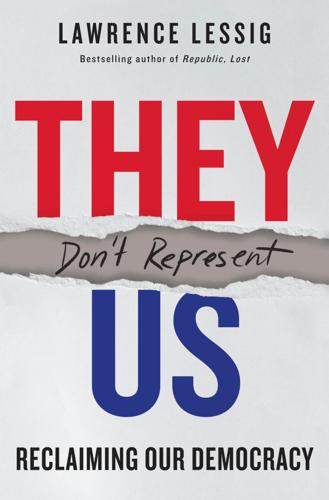
They Don't Represent Us: Reclaiming Our Democracy
by
Lawrence Lessig
Published 5 Nov 2019
For those who would abuse it, it becomes just another lever to be manipulated in the game of public policy making. The random (or ignorant) get deployed to help one side or harm the other. Our ignorance becomes predictable. It becomes cheap to evince. For those who would oppose democracy, it becomes just another argument for an alternative. Bestselling author Parag Khanna describes two models of governance in his 2017 book, Technocracy in America. In one, the government focuses on governing. In the other, it focuses on democracy. Not surprisingly, governments like the first, in Khanna’s account, do more to deliver the services of government than governments like the second.
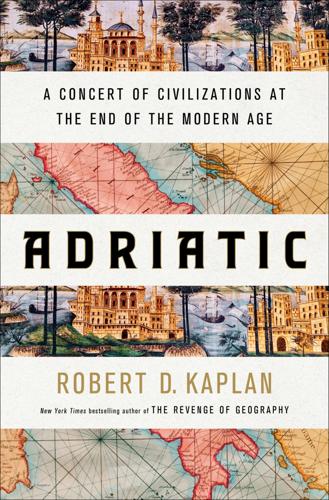
Adriatic: A Concert of Civilizations at the End of the Modern Age
by
Robert D. Kaplan
Published 11 Apr 2022
BACK TO NOTE REFERENCE 22 Ballinger, History in Exile, pp. 129 and 144. BACK TO NOTE REFERENCE 23 Reill, Nationalists Who Feared the Nation, pp. 1–3. BACK TO NOTE REFERENCE 24 Ivan Krastev, After Europe (Philadelphia: University of Pennsylvania Press, 2017), p. 11. BACK TO NOTE REFERENCE 25 Parag Khanna, “Connectivity and Strategy: A Response to Robert D. Kaplan,” CNAS Stories, www.cnas.org, May 2017. BACK TO NOTE REFERENCE 26 Manent, Metamorphoses of the City, pp. 3, 13, 18–19, and 319–20. Ian Buruma, “In the Capital of Europe,” New York Review of Books, April 7, 2016. BACK TO NOTE REFERENCE 27 Mark Mazower, Governing the World: The History of an Idea, 1815 to the Present (New York: Penguin Press, 2012), p. 49.

The Ascent of Money: A Financial History of the World
by
Niall Ferguson
Published 13 Nov 2007
Williamson (eds.), Globalization in Historical Perspective (Chicago, 2003), pp. 173f. 13 Clark, Farewell, chs. 13, 14. 14 David M. Rowe, ‘The Tragedy of Liberalism: How Globalization Caused the First World War’, Security Studies, 14, 3 (Spring 2005), pp. 1-41. 15 See for example Fareed Zakaria, The Post-American World (New York, 2008) and Parag Khanna, The Second World: Empires and Influence in the New Global Order (London, 2008). 16 Jim Rogers, A Bull in China: Investing Profitably in the World’s Greatest Market (New York, 2007). 17 Robert Blake, Jardine Matheson: Traders of the Far East (London, 1999), p. 91. See also Alain Le Pichon, China Trade and Empire: Jardine, Matheson & Co. and the Origins of British Rule in Hong Kong, 1827-1843 (Oxford / New York, 2006). 18 Rothschild Archive London, RFamFD/13A/I; 13B/1; 13C/I; 13D/1; 13D/2; 13/E. 19 Henry Lowenfeld, Investment: An Exact Science (London, 1909), p. 61. 20 John Maynard Keynes, The Economic Consequences of the Peace (London, 1919), ch. 1. 21 Maddison, World Economy, table 2-26a. 22 Lance E.

The New Digital Age: Transforming Nations, Businesses, and Our Lives
by
Eric Schmidt
and
Jared Cohen
Published 22 Apr 2013
Our gratitude to all our friends and colleagues whose ideas and thoughts we’ve benefited from: Elliott Abrams, Ruzwana Bashir, Michael Bloomberg, Richard Branson, Chris Brose, Jordan Brown, James Bryer, Mike Cline, Steve Coll, Peter Diamandis, Larry Diamond, Jack Dorsey, Mohamed El-Erian, James Fallows, Summer Felix, Richard Fontaine, Dov Fox, Tom Freston, Malcolm Gladwell, James Glassman, Jack Goldsmith, David Gordon, Sheena Greitens, Craig Hatkoff, Michael Hayden, Chris Hughes, Walter Isaacson, Dean Kamen, David Kennedy, Erik Kerr, Parag Khanna, Joseph Konzelmann, Stephen Krasner, Ray Kurzweil, Eric Lander, Jason Liebman, Claudia Mendoza, Evgeny Morozov, Dambisa Moyo, Elon Musk, Meghan O’Sullivan, Farah Pandith, Barry Pavel, Steven Pinker, Joe Polish, Alex Pollen, Jason Rakowski, Lisa Randall, Condoleezza Rice, Jane Rosenthal, Nouriel Roubini, Kori Schake, Vance Serchuk, Michael Spence, Stephen Stedman, Dan Twining, Decker Walker, Matthew Waxman, Tim Wu, Jillian York, Juan Zarate, Jonathan Zittrain and Ethan Zuckerman.
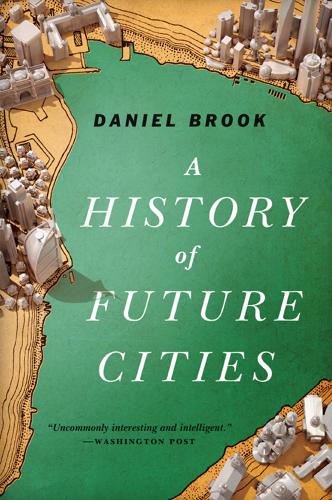
A History of Future Cities
by
Daniel Brook
Published 18 Feb 2013
Hines, Times Literary Supplement “Whatever the futures of these four cities hold, Brook cautions that progress and growth need more than construction projects and infrastructure.” —Daily Beast “Penetrating. . . . [Brook] sketches a portrait of a place that is not just a city, but an idea, and a dream.” —Parag Khanna, CNN “A fascinating and erudite look at where westernization ends and modernization begins. . . . [P]rofound and profoundly hopeful.” —Mark Pabst, Financialist “[An] engaging, quite original take on urban planning. . . . Wholly readable.” —Alan Moores, Seattle Times “Meticulously researched. . . .

Smart Cities: Big Data, Civic Hackers, and the Quest for a New Utopia
by
Anthony M. Townsend
Published 29 Sep 2013
“These city leaders are nonideological,” Palmisano posited, echoing storied New York City Mayor Fiorello LaGuardia, who famously said “There is no Democratic or Republican way of cleaning the streets.” Palmisano concluded, “They get things done. . . . Smarter city leaders think—and manage—for the long term.”58 At the very least, for the next election. Today, cities are the most pragmatic and effective level of government. In an era of gridlock at the national level, as Parag Khanna and David Skilling, who both serve as foreign policy advisors to the nation-state of Singapore, have argued in their essay “Big Ideas from Small Places,” “cities and provinces around the world are assuming a more important leadership role on global policy issues.”59 Even as they grow larger, cities maintain a sense of shared destiny that mobilizes people to work together.

The Billionaire Raj: A Journey Through India's New Gilded Age
by
James Crabtree
Published 2 Jul 2018
In particular, my understanding has been helped immeasurably by conversations with Reuben Abraham, Swaminathan Aiyar, Mukulika Banerjee, Jagdish Bhagwati, Sanjay Bhandarkar, Surjit Bhalla, Sidharth Bhatia, Katherine Boo, Praveen Chakravarty, Sajjid Chinoy, Gurcharan Das, Gaurav Dalmia, Gerson da Cunha, William Dalrymple, Ridham Desai, Sadanand Dhume, Amitabh Dubey, Naresh Fernandes, Anant Goenka, Harsh Goenka, Anthony Good, Ramachandra Guha, Nisid Hajari, Ishaat Hussain, Kumar Iyer, Zahir Janmohamed, Akash Kapur, Bharat Kewalramani, Jaideep Khanna, Parag Khanna, Mukul Kesavan, Manjeet Kripalani, Rajiv Lall, Brijesh Mehra, Pratap Bhanu Mehta, Saurabh Mukherjea, Anant Nath, PJ Nayak, Sanjay Nayar, Nandan Nilekani, Nitin Pai, Anuvab Pal, Deepanjana Pal, Jay Panda, Nick Paulson-Ellis, Basharat Peer, Stanley Pignal, Eswar Prasad, Naman Pugalia, Vinod Rai, Raghuram Rajan, Adam Roberts, Alan Rosling, Vijay Sankar, Amartya Sen, Neelanjan Sircar, Ruchir Sharma, Arun Shourie, Arvind Subramanian, Shashi Tharoor, Mark Tully, Siddharth Varadarajan, Gilles Vernier, and Adil Zainulbhai.

Likewar: The Weaponization of Social Media
by
Peter Warren Singer
and
Emerson T. Brooking
Published 15 Mar 2018
utm_term=.3b666b5148d2. 263 clearest “losers”: Ibid. 263 Finland, Estonia: Reid Standish, “Russia’s Neighbors Respond to Putin’s ‘Hybrid War,’” Foreign Policy, October 12, 2017, http://foreignpolicy.com/2017/10/12/russias-neighbors-respond-to-putins-hybrid-warlatvia-estonia-lithuania-finland/. 264 single cabinet-level meeting: Haley Britzky, “Report: Trump Never Held a High-Level Meeting on Russian Interference,” Axios, December 14, 2017, https://www.axios.com/trumps-inability-to-recognize-1513298165-1d94485c-9fd2-4c84-b552-1299706176ec.html. 264 nearly $80 million: Nahal Toosi, “Tillerson Spurns $80 Million to Counter ISIS, Russian Propaganda,” Politico, August 8, 2017, https://www.politico.com/story/2017/08/02/tillerson-isis-russia-propaganda-241218. 264 cannot start early enough: Lisa Guernsey, “It’s Never Too Early to Start Teaching Kids Media Literacy,” Slate, November 8, 2017, http://www.slate.com/articles/technology/future_tense/2017/11/in_the_age_of_fake_news_it_s_never_too_early_to_teach_kids_media_literacy. 264 at least a dozen: Michael Rosenwald, “Making Media Literacy Great Again,” Columbia Journalism Review, Fall 2017, https://www.cjr.org/special_report/media-literacy-trump-fake-news.php. 264 Calling Bullshit: “Calling Bullshit: Data Reasoning in a Digital World” (course syllabus, University of Washington, Autumn 2017), http://callingbullshit.org/syllabus.html. 265 “conscientious objector”: Thuy Ong, “Sean Parker on Facebook: ‘God Only Knows What It’s Doing to Our Children’s Brains,’” The Verge, November 9, 2017, https://www.theverge.com/2017/11/9/16627724/sean-parker-facebook-childrens-brains-feedback-loop. 265 “our children’s brains”: Ibid. 265 Such “technocracy” views: Parag Khanna, “To Beat Populism, Blend Democracy and Technocracy, S’pore Style,” Straits Times, January 21, 2017, http://www.straitstimes.com/opinion/to-beat-populism-blend-democracy-and-technocracy-spore-style. 265 the Flux movement: Mark Kaye and Nathan Spataro, “Redefining Democracy: On a Democratic System Designed for the 21st Century, and Disrupting Democracy for Good” (unpublished paper, January 2017), https://voteflux.org/pdf/Redefining%20Democracy%20-%20Kaye%20&%20Spataro%201.0.2.pdf. 266 “dangerous speech”: “Understanding Dangerous Speech,” Dangerous Speech Project, accessed March 12, 2018, https://dangerousspeech.org/faq/. 268 “The more we connect”: Chris Matyszcyk, “Facebook’s New Ads Aren’t as Friendly as They Seem,” CNET, February 16, 2015, https://www.cnet.com/news/facebooks-new-ads-arent-as-friendly-as-they-seem/. 268 like Mark Zuckerberg: Mark Zuckerberg, “I Wanted to Share Some Thoughts on Facebook and the Election,” Facebook, November 12, 2016, https://www.facebook.com/zuck/posts/10103253901916271; Callum Bor-chers, “Twitter Executive on Fake News: ‘We Are Not the Arbiters of Truth,’” The Fix (blog), Washington Post, February 8, 2018, https://www.washingtonpost.com/news/the-fix/wp/2018/02/08/twitter-executive-on-fake-news-we-are-not-the-arbiters-of-truth/?

Imagining India
by
Nandan Nilekani
Published 25 Nov 2008
The Indian community has spread its roots across the world, from the eighteenth-century indentured laborers who were shipped to Southeast Asia and Europe to the immigrants to the Commonwealth through the 1950s and the engineers emigrating to the United States in the 1970s. So far and wide has the community spread that, as the writer Parag Khanna noted, “The sun never sets on the Indian diaspora.” And these Indians have been a ready conduit for the country’s soft power, in terms of our film, literature, art and music. Our attitudes toward our NRI community have changed as our economyhas globalized. Dr. Vijay Kelkar remembers how Indira Gandhi arranged a conference of senior Indian economists in 1980 to discuss the problem of “brain drain” from India—the government considered skilled Indians leaving for jobs abroad a major problem.

Aftermath: Following the Bloodshed of America's Wars in the Muslim World
by
Nir Rosen
Published 21 Apr 2011
Ricks, author of Fiasco and The Gamble “The world would be a more dangerous place without Nir Rosen’s Aftermath. His bracing recounting of the invasion of Iraq and subsequent insurgency, and blunt dissection of the myths surrounding the surge are an essential antidote to the complacency that has set in as America exits Iraq—and which could lead to similar debacles in the future.” —Parag Khanna, author of The Second World: How Emerging Powers Are Redefining Global Competition in the Twenty-first Century “Aftermath is a masterwork, the product of a life devoted to a relentless pursuit of the knowledge and understanding of strange men who walk in nearly unimaginable paths across the far places of the world.